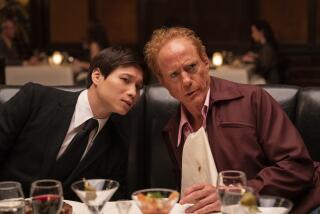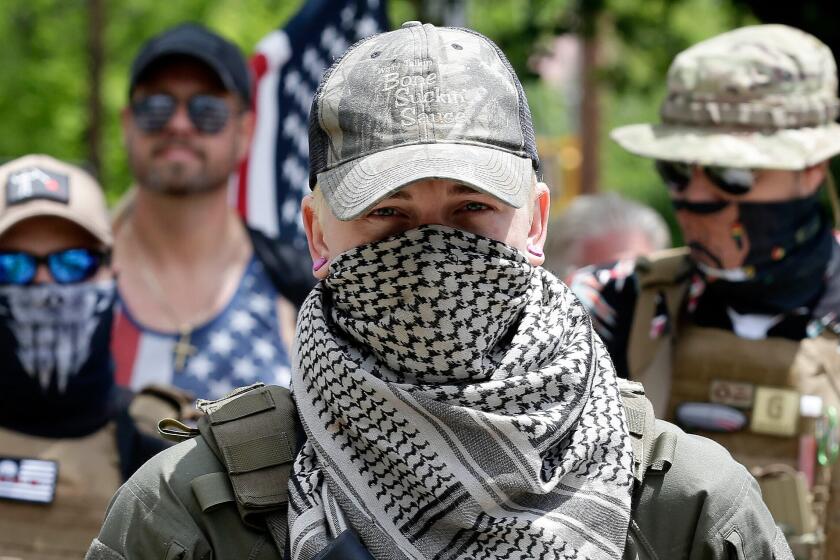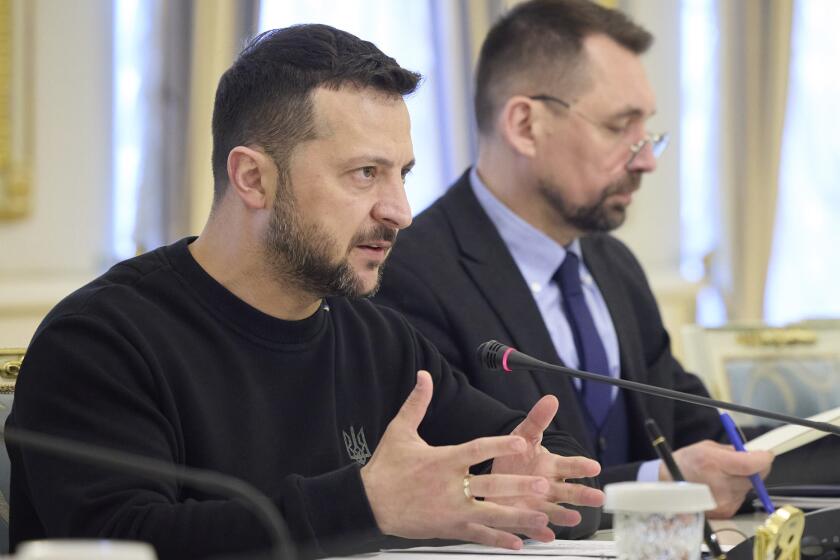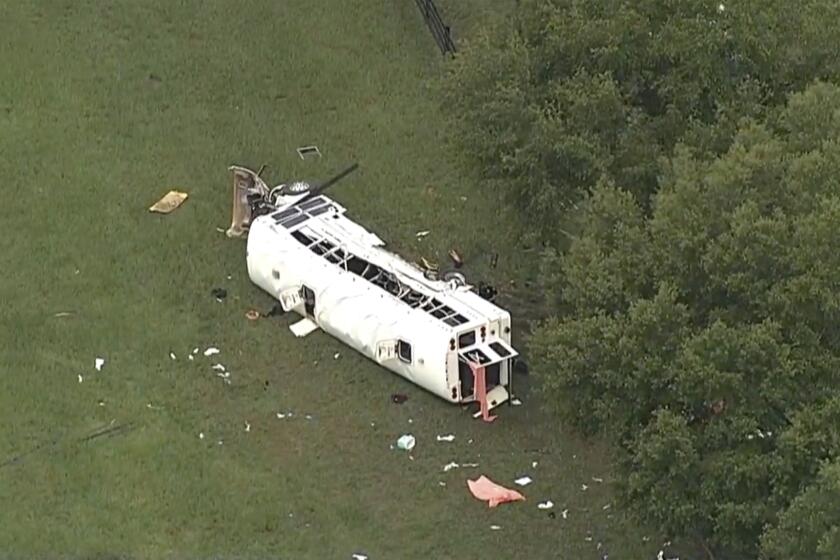Quest for Justice : Push for Tribunal on Cambodian Genocide Lost Key Leader With Ngor’s Death
Until his death 11 days ago, actor Haing S. Ngor was the most visible champion of the little-known international effort to bring the leaders of the Pol Pot regime in Cambodia to justice.
“I feel like I lost my twin brother,” said Dith Pran, who worked with Ngor for more than a decade to rouse global public opinion over the deaths of 1.7 million Cambodians at the hands of the Khmer Rouge. “Now I’ll have to continue with one hand, carrying Ngor’s picture and spirit with me.”
From 1975 to 1979, Pol Pot’s followers waged a campaign to turn Cambodia into a farming commune where people would dress alike and submit themselves to the central government. Cities were emptied and people forced to work in the fields with little food or shelter.
The grief of atrocities survived and loved ones lost is never far from the minds of Cambodian refugees in the United States, 55,000 of whom live in Southern California. Many suffer from recurring nightmares; the refugees also have higher rates of poverty, unemployment and poor health than other Asian immigrant groups.
And many saw Ngor as a symbol of strength and success, a physician who turned actor and won an Oscar for his portrayal of Dith’s ordeal under Pol Pot. Ngor used his fame and money to work publicly with Dith against the Khmer Rouge. Their goal: an international tribunal to prosecute Pol Pot and his henchmen.
Today, 17 years after his ouster from power, Pol Pot lives in comfort with his family on the Thai-Cambodian border, plotting to resume his brand of Maoist-inspired revolution, with a well-equipped army of nearly 10,000, according to authorities on Southeast Asia.
Ngor, 55, was shot to death Feb. 25 outside his Los Angeles home on the edge of Chinatown. His funeral is scheduled for Friday from 10 a.m. to 1 p.m. at Chung Wa Funeral Home, 2730 N. Broadway in Los Angeles, followed by burial at 3 p.m. at Rose Hills Memorial Park in Whittier.
As much as they admired Ngor’s courage in his public campaign for justice, many in the U.S. Cambodian community believe his quest caused his death. Police do not know the motive for the shooting, but the rumor in the refugee community is: political assassination. And the immigrants are afraid.
“My patients are saying, ‘Look what happened to Ngor. If you talk against Khmer Rouge, you’re going to die,’ ” said Mary Scully, a psychiatric nurse and executive director of Khmer Health Advocates in West Hartford, Conn.
In Long Beach, which has the largest Cambodian community in the nation, refugees wonder who is going to be next, said Borann Duong, editor of the Cambodian language biweekly Cam News.
“I think Khmer Rouge agents are here--I am afraid to talk,” said a social worker with a Long Beach Cambodian community group who asked that her name not be disclosed. Her father was killed by the Khmer Rouge.
David Khay, a survivor of the Cambodian holocaust who now lives in Long Beach, says he knows why the international community has been so indifferent to the survivors of Pol Pot’s reign.
“Cambodia is a small Asian country that people don’t know and don’t much care about,” he said. “Nazis were tried at Nuremberg, and Bosnian and Rwandan genocides have led [to the establishment of] international tribunals. But nothing has happened to Pol Pot even though everybody knows he is in hiding on the Thai border.”
*
At one of a series of traditional memorial services for Ngor at the United Cambodian Community Center in Long Beach on a recent evening, Buddhist monks in saffron robes knelt on the floor, chanting.
Outside, mourners pondered whether the effort to prosecute would be worth the pain of reliving past horrors.
“Eventually, the people want to get the Khmer Rouge to trial,” said Siphan Phay, 42, who escaped from a work camp outside Phnom Penh. “But the gain from that? I don’t see that.”
Siphan, a cook in his uncle’s Long Beach restaurant, said he was a law student in 1975 when soldiers swept him and thousands of others out of the capital into a labor camp. He toiled in rice fields for 12 hours a day and slept in a hammock made out of rice sacks.
“Every night, they would come to pick up a few people to shoot,” he said. “If you wore glasses, they thought you were an intellectual.”
One night in 1976, the soldiers rounded him up with 11 others and locked them in the back of a military truck. At 5 a.m., a hail of mortar fire rained down near the site, and the prisoners broke out of the truck after their guards fled, he said.
Siphan’s tale is similar to those of his fellow refugees, including the two most famous.
After the Khmer Rouge takeover in 1975, Ngor, a physician, was arrested and tortured. He survived by telling his captors that he was a taxi driver, sticking with the story even when his tormentors put him in a bag, beat him and struck his ankle with an ax.
In 1980, Ngor, whose wife had died in childbirth while imprisoned, came to Los Angeles with $4 in his pocket. He was working as a counselor for refugees in Chinatown when he landed the role as Dith in the 1984 film “The Killing Fields.”
Dith had been an assistant to a New York Times correspondent in Cambodia. With the Khmer Rouge takeover, Dith was imprisoned and tortured because of his association with a U.S. newspaper.
After they met in the United States, Dith and Ngor spent a decade and a half traveling to the White House, Congress and capitals around the world trying to mobilize international public opinion against the Khmer Rouge.
It took them more than a decade of lobbying to drum up support for enactment of the Cambodia Genocide Act of 1994, which mandated government-funded studies of the carnage. The act fell far short of Ngor’s goal.
“He used to tell me, ‘Why does the world ignore us? Is it because of our skin?’ ” recalled Dith, now a photographer for the New York Times.
Ngor died before seeing his dream come close to fruition. But he and Dith sowed the seeds of a movement that has gained a momentum of its own.
*
Researchers at the Cambodian Genocide Program at Yale University have been amassing and organizing evidence on the Khmer Rouge era for more than a year, including 5,500 pictures of victims and 25,000 pages of documents. The $500,000 project, headed by Yale historian Ben Kiernan, was made possible by the federal law for which Ngor and Dith lobbied.
The information will be made available on the Internet in 1997, Kiernan said.
His group is also training Cambodian lawyers and jurists in international criminal and human rights law at its sister office in Phnom Penh.
That office has located tens of thousands of previously unknown mass graves in recent months, according to Craig Etcheson, deputy director of the Yale program.
Etcheson, currently working in Phnom Penh, said the consensus of the international community is to wait for Cambodia to take the initiative in seeking an international trial of Khmer Rouge leaders, then lend support.
On the legal front, professor Steven R. Ratner of the University of Texas Law School and Jason S. Abrams, a consultant in international law, recently completed a study for the State Department that says there is ample evidence for a trial on charges of crimes against humanity, including genocide.
But Ratner also sees it as Cambodia’s duty to move first.
“It is a moral imperative for Cambodia in order to provide some sort of closure and feeling of justice for the victims,” he said.
*
Sam San, a former Cambodian military officer now living in Santa Ana who came to pay respects to Ngor at the recent Long Beach memorial service, said he wants to see the United States take the lead in bringing the guilty to justice, without waiting for Cambodia to move first.
“If we do not lead, who else will?” asked Sam, who has been separated from his wife and two surviving children for 21 years. “We have the capability.”
Four months before the fall of the Cambodian government, while the Khmer Rouge insurgents were gaining strength in early 1975, Sam, a young captain in the Cambodian military, arrived with his unit at an Air Force base in San Antonio. Once the Khmer gained power, he could not go back.
His wife, two sons and a daughter were enslaved for nearly four years and his daughter was killed during that time. The other three escaped across the border to Thailand and eventually to Australia.
Sam, who is a volunteer English teacher for Cambodians, said he has neither the money nor immigration status to sponsor his family’s move to the United States.
“We want a worthwhile life,” he said. “We don’t want a life of atrocity.”
But he and other refugees warn that large segments of the Cambodian population would be afraid to testify against their former captors, even two decades after the war.
“Cambodian survivors live in quiet misery,” said family therapist Theanvy Kouch, a survivor who works at a Cambodian health clinic in West Hartford. “We have no voices. The world does not pay attention to us.”
More to Read
Start your day right
Sign up for Essential California for news, features and recommendations from the L.A. Times and beyond in your inbox six days a week.
You may occasionally receive promotional content from the Los Angeles Times.






